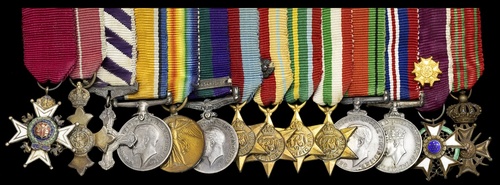
Auction: 25001 - Orders, Decorations and Medals
Lot: 441
The outstanding Second World War C.B., 'Southern Desert, Iraq' O.B.E., Great War Fighter "Aces" D.F.C. mounted group of fourteen miniature dress medals worn by Dolphin Pilot Air Commodore F. Woolley, Royal Air Force
Credited with 4 victories, but possibly as many as 8 from July to November 1918, he served as a Special Service Officer with Air Staff Intelligence in Iraq where he spent three years in the desert with Bedouin tribesmen collating intelligence
During the Second War he served as Chief Intelligence Officer, Headquarters Mediterranean Allied Air Forces 1943-45
The Most Honourable Order of the Bath, Companion's (C.B.) Badge, silver-gilt and enamel; Order of the British Empire, Military Division, Officer's (O.B.E.) Badge, silver-gilt; Distinguished Flying Cross, G.V.R.; British War and Victory Medals 1914-18; General Service 1918-62, G.V.R., 1 clasp, Southern Desert, Iraq; 1939-45 Star; Africa Star with rose on riband; Pacific Star; Italy Star; Defence and War Medals 1939-45; United States of America, Legion of Merit, gilt and enamel, with miniature Star on riband; Belgium, Kingdom, Croix de Guerre, mounted as worn, slight wear to enamel on Order of the Bath, overall very fine (14)
His full-size medals sold in these rooms in April 2014.
C.B. London Gazette 1 January 1946.
O.B.E. London Gazette 3 June 1931. The original recommendation reads:
'This Officer has been a Special Service Officer in Iraq since March 1928. Although occupying the most lonely and isolated post in the whole Command, he has consistently displayed, under extremely trying conditions, a tact, patience, and perseverance which are worthy of the highest praise.'
D.F.C. London Gazette 3 June 1919.
M.I.D. London Gazette 2 June 1943.
United States, Legion of Merit London Gazette 27 November 1945. The original recommendation reads:
'Air Commodore Frank Woolley, Royal Air Force, as Chief Intelligence Officer, Headquarters Mediterranean Allied Air Forces from February 1943 to May 1945, displayed wise judgment and unqualified devotion to duty in the successful fulfilment of his assignment. Called upon to furnish a synthesis of all intelligence information regarding conduct of operations and to integrate the Anglo-American intelligence structure of the headquarters, he overcame many obstacles to provide source information of high value and veracity and at the same time achieved a smoothly functioning, closely knit intelligence organization. Commodore Woolley's exceptional ability was of great benefit to the conduct of air operations.'
Belgium, Croix de Guerre London Gazette 15 July 1919.
Frank Woolley was born in Ilkeston, Derbyshire in 1899 and was educated at the County Secondary School. He joined the Army straight from his school O.T.C. on his 18th birthday, and was accepted for a Commission in the Territorial Forces Association. Posted to the 7th Training Reserve Battalion at Rugeley, he subsequently applied to join the Royal Flying Corps, and after initial tutoring at Denham was Commissioned a Second Lieutenant in the R.F.C. on 7 November 1917.
Woolley went to France in July 1918 where he was posted to No.1 Aero Supply Depot before receiving his first operational posting on 14 July with No. 79 Fighter Squadron (Sopwith Dolphins), based at St. Marie Cappel east of St. Omer, with whom he fought and flew for the rest of the War. He was without doubt heavily engaged with the enemy for the next four months, '...and the local papers in his home town of Ilkeston credited him with eight victories, and recorded that he himself had been shot or forced down no fewer than three times, evidence of an exciting four months' flying.' (Winged Warriors, Derbyshire Fighter Pilots in World War I, by Barry Marsden refers).
His first victory occurred on 27 September, when, according to an account that appeared in the Ilkeston Advertiser, 'he was on readiness at his home base when word was received that an enemy two seater was busy on a reconnaissance over the British front line. He was ordered to intercept the hostile aircraft, and, piloting a Dolphin, sighted it below him somewhere north-west of Armentieres. The first burst from his twin Vickers killed the enemy observer, and the subsequent running battle took both warplanes over the town, where the observation machine suddenly dived away to smash through the roof of a building. When Frank landed back at his home airfield his delighted CO praised his "splendid effort", and promised that "the facts would be reported to the proper quarter".' (ibid).
Woolley's own account of the action confirms this: 'I was at 2,000 feet among the clouds South West of Armentieres when I saw a hostile 2-seater, probably an Albatros, about 1,000 feet below me. On being engaged the enemy aircraft dived towards Armentieres. I dived after him and fired two bursts into him at close range. The enemy aircraft spun and crashed into a house in Armentieres.' (recipient's combat report refers).
The following day Woolley shot down another aircraft: 'I saw 10 Fokker Biplanes attacking a Bristol Fighter. I climbed into a cloud at 6,000 feet whilst Lieutenant McNeaney attacked the enemy machines. A dog fight ensued in which I saw two Fokkers go down after which Lieutenant McNeaney went down, followed by a Fokker. I attacked this enemy aircraft and fired a short burst at point blank range, and saw him go down and crash.' (Ibid).
A month later on 26 October, Woolley despatched an L.V.G. two-seater at 3,000 feet south-east of Renaix before recording his final confirmed victory on 4 November, when 'at 9,000 feet I spotted a Halberstadt two-seater working over Renaix. I flew north and then east and so got east of him and in the sun. I then dived on the enemy aircraft who turned west and then north. I fired a burst at very close range. The enemy aircraft went into a vertical dive and crashed in a gulley between Sulsique and Renaix.' (Ibid).
After the Armistice Woolley took up adjutant duties with the Squadron and became a Flight Commander, the Squadron became part of the Allied Occupation Force in December and moved to Cologne. Here he accepted the opportunity to fly numerous surrendered German aircraft, including Fokker DVIIs, Rumplers, and Halberstadts. Whilst stationed in Germany he learnt of the award of his D.F.C. and also received the Belgian Croix de Guerre, having the latter pinned on his chest by King Albert himself. He transferred to the unemployed list in October 1919, but was recalled to a short-service Commission the following June and served at R.A.F. Lee-on-Solent and Calshot. Qualifying as a pilot flying seaplanes and multi-engined flying boats, he fell in love with the Solent area, and wrote to tell his fiancée: 'I am sure that you will love this place too, and if I live long enough to retire this is where we shall live.'
Southern Desert, Iraq - With the Bedouin
In July 1927 Woolley was appointed to a permanent Commission in the General Duties branch of the Royal Air Force and, having been promoted Flight Lieutenant in January 1928, he embarked upon a course in Arabic at the School of Oriental Studies in London. After completing the course in March he was immediately posted to HQ Iraq as a Special Service Officer with Air Staff Intelligence, and for the next three years was responsible for the collection of intelligence in the vast unmapped desert west of Basra, spending the time living with the Bedouin tribesmen, 'sharing the hardships of their primitive, nomadic lifestyle, enduring searing heat, frequent dust and sandstorms, plagues of flies, and living off revolting food and foul water.' (Winged Warriors refers).
Separated from any form of civilisation by hundreds of miles of desert, with wireless transmitted Morse code his only form of contact, his task was to obtain information on the activities of hostile tribes operating from Saudi Arabia. During his time in Iraq he maintained close contact with Major (later Sir John) Glubb, Glubb Pasha, the founder of the Arab Legion, who had been seconded from the Royal Engineers to the Iraqi Government as Administrative Inspector. In recognition of his sterling service under the most trying conditions, Woolley was awarded a richly deserved O.B.E. in June 1931. His next job in the Middle East was to visit and provide intelligence on the local Sheikhs through whose territory the pipeline was being built from the Arabian oil fields to the sea ports at Haifa and Tripoli, before returning to flying duties in the U.K., including torpedo bombing in co-operation with the Royal Navy.
A New War - The Same Game
On the outbreak of the Italian-Abyssinian War, Woolley was posted to the Sudan by air to reorganise the rudimentary intelligence facilities in that area, perceived as vital if Britain were to be successfully involved in any hostilities, which at a time seemed likely. He was promoted Squadron Leader in June 1936. When the crisis came to an end he went to Singapore as Senior Air Staff Officer to Air Commodore (later Marshal of the Royal Air Force) Tedder, AOC Far East Command. Promoted Wing Commander in April 1939, Woolley served during the Second World War, first in Singapore; then in Ceylon, with the rank of Group Captain, where he formed and commanded No. 222 Group, a task which involved the construction of airfields and other bases for operating bombers, fighters, and reconnaissance aircraft to combat a Japanese attack on the island; and then, with the rank of acting Air Commodore, in Algiers on the staff of Air Chief Marshal Sir Arthur Tedder as Chief Intelligence Officer, Mediterranean Air Command HQ, a post he held until in various guises the end of the War.
Recommended for a C.B.E. at the end of hostilities, the recommendation stating: 'this Officer has been Chief Intelligence Staff Officer since September 1943, and has not only been responsible for the whole range of intelligence activities in the Mediterranean and North-African theatres, but also the organisation and building up of an integrated Anglo-American intelligence structure.' He was instead created a Companion of the Order of the Bath, and awarded the American Legion of Merit, receiving the latter in Cairo from Major General Benjamin Giles, Commander of United States Forces Middle East.
On his return to the U.K., Woolley was given the command of R.A.F. Lyneham, during which period it became the main base for the British contribution to the Berlin Airlift in 1947, before returning to staff duties as Assistant Director of the Joint Intelligence Bureau at the Ministry of Defence. He retired on 6 August 1954 with the rank of Air Commodore after 37 years with the Royal Air Force, during which period he had flown 54 different types of aircraft, from a Dolphin to a Vampire.
Woolley married Gladys Willgoose at Ilkeston in August 1921 and as promised later retired to Lee-on-Solent, where in 1971 they celebrated their Golden Wedding Anniversary. His son, Frank Geoffrey Woolley, served with the Royal Air Force in the Second World War, and like his father received a D.F.C. before his twentieth birthday.
Subject to 20% VAT on Buyer’s Premium. For more information please view Terms and Conditions for Buyers.
Estimate
£250 to £350
Starting price
£200




